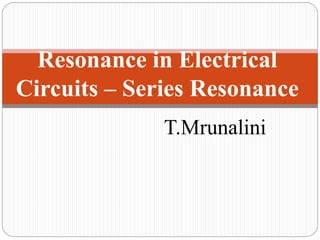
Resonance in electrical circuits – series resonance
- 1. T.Mrunalini Resonance in Electrical Circuits – Series Resonance
- 2. Electrical Resonance Resonance describes the phenomenon of increased amplitude that occurs when the frequency of a periodically applied force (or a Fourier component of it) is equal or close to a natural frequency of the system on which it acts. Electrical resonance occurs in an electric circuit at a particular resonant frequency when the impedances or admittances of circuit elements cancel each other. In some circuits, this happens when the impedance between the input and output of the circuit is almost zero and the transfer function is close to one.
- 3. The resonance of a series RLC circuit occurs when the inductive and capacitive reactance are equal in magnitude but cancel each other because they are 180 degrees apart in phase. The sharp minimum in impedance which occurs is useful in tuning applications.
- 4. Application One application for resonance is to establish a condition of stable frequency in circuits designed to produce AC signals. Usually, a parallel (tank) circuit is used for this purpose, with the capacitor and inductor directly connected together, exchanging energy between each other.
- 5. Working A resonant circuit is formed when a capacitor and inductor (coil) are in parallel or in series. The two circuit elements will block or pass a single specific frequency out of a divers mix. For this reason, resonant circuits make possible radio and TV transmission and reception and perform many other useful tasks.
- 7. Series Resonance Series Resonance circuits are one of the most important circuits used electrical and electronic circuits. They can be found in various forms such as in AC mains filters, noise filters and also in radio and television tuning circuits producing a very selective tuning circuit for the receiving of the different frequency channels.
- 8. In a series RLC circuit there becomes a frequency point were the inductive reactance of the inductor becomes equal in value to the capacitive reactance of the capacitor. In other words, XL = XC. The point at which this occurs is called the Resonant Frequency point, ( ƒr ) of the circuit.
- 10. • This makes the series LC combination act as a short circuit with the only opposition to current flow in a series resonance circuit being the resistance, R. • In complex form, the resonant frequency is the frequency at which the total impedance of a series RLC circuit becomes purely “real”, that is no imaginary impedance’s exist. This is because at resonance they are cancelled out. So the total impedance of the series circuit becomes just the value of the resistance and therefore: Z = R.
- 11. Series Circuit Current at Resonance
- 13. Bandwidth of a Series Resonance Circuit • If the series RLC circuit is driven by a variable frequency at a constant voltage, then the magnitude of the current, I is proportional to the impedance, Z, therefore at resonance the power absorbed by the circuit must be at its maximum value as P = I2Z. • Upon reducing or increasing the frequency until the average power absorbed by the resistor in the series resonance circuit is half that of its maximum value at resonance, we produce two frequency points called the half-power points which are -3dB down from maximum, taking 0dB as the maximum current reference.
- 14. These -3dB points provide the current value that is 70.7% of its maximum resonant value which is defined as: 0.5( I2 R ) = (0.707 x I)2 R. Then the point corresponding to the lower frequency at half the power is called the “lower cut-off frequency”, labelled ƒL with the point corresponding to the upper frequency at half power being called the “upper cut-off frequency”, labelled ƒH. The distance between these two points, i.e. ( ƒH – ƒL ) is called the Bandwidth, (BW) and is the range of frequencies over which at least half of the maximum power and current is provided as shown.
- 16. Quality Factor • The frequency response of the circuits current magnitude shown in the previous slide, relates to the “sharpness” of the resonance in a series resonance circuit. The sharpness of the peak is measured quantitatively and is called the Quality factor, Q of the circuit. The quality factor relates the maximum or peak energy stored in the circuit (the reactance) to the energy dissipated (the resistance) during each cycle of oscillation meaning that it is a ratio of resonant frequency to bandwidth and the higher the circuit Q, the smaller the bandwidth, Q = ƒr /BW.
- 18. Thank you